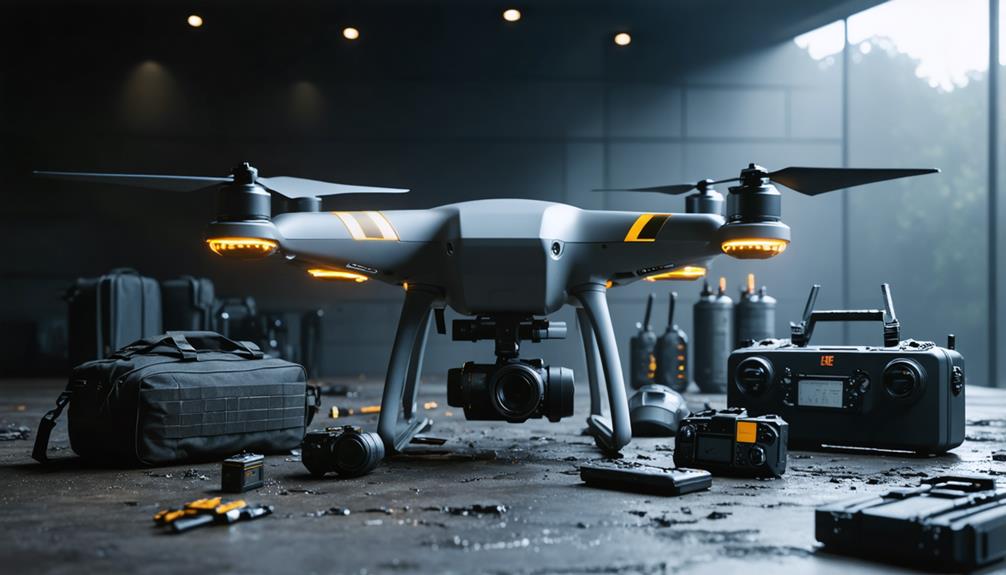
Brainstorm Security Shop

For Orders Over $199

On Any Of Our Products

Details On Refund Page
When you consider the scope of defense products, it’s clear they’re not just about weapons and vehicles; they encompass a vast array of technologies aimed at enhancing security. You might find it interesting how advancements in areas like cybersecurity and surveillance are shaping modern military strategies. As threats evolve, so do the tools designed to counter them. But what does this mean for future national security and technological innovation? The implications could be more significant than you realize.
Defense products encompass a wide range of technologies and equipment designed to protect nations and their interests. When you delve into this sector, you’ll find that it’s driven by a need for security and deterrence. Conducting a market analysis is crucial for understanding the dynamics at play. You’ll notice that countries are increasingly investing in advanced defense systems, which creates both opportunities and challenges.
As you explore the landscape, you’ll see global competition intensifying. Nations aren’t just focused on bolstering their own capabilities; they’re also keen on keeping pace with rivals. This competition pushes manufacturers to innovate and improve their offerings continually.
You might find that partnerships and collaborations are common as countries seek to combine resources and expertise.
Moreover, the market is influenced by geopolitical shifts, which can alter demand for specific defense products. By staying informed about these trends, you can better grasp how emerging technologies and strategic alliances shape the industry. It’s essential to analyze these factors to understand how they impact the availability and effectiveness of defense products on a global scale.
As global competition intensifies, the latest technological innovations in defense are reshaping the landscape of military capabilities. You’re witnessing a revolutionary shift as military drones become increasingly sophisticated, offering unprecedented surveillance and strike capabilities. These unmanned aerial vehicles (UAVs) aren’t just enhancing real-time intelligence but also minimizing risks to personnel in combat situations. With advanced sensors and AI integration, you can expect drones to perform complex missions autonomously, providing strategic advantages on the battlefield.
Moreover, cyber warfare is emerging as a pivotal domain in modern defense strategies. Countries are investing heavily in cyber capabilities to protect their critical infrastructure and disrupt adversaries.
You need to understand that a robust cyber defense is as crucial as physical armaments. Innovations in encryption, threat detection, and response systems are being developed to stay ahead in this invisible war.
In today’s rapidly evolving military landscape, understanding the key categories of defense products is essential for anyone involved in security and strategy. You’ll find that military equipment forms the backbone of defense operations. This category includes everything from advanced weaponry and vehicles to tactical gear and drones. Each piece of military equipment is designed to enhance combat effectiveness and ensure the safety of personnel.
Another critical category revolves around security systems. These systems encompass a wide range of technology, including surveillance cameras, intrusion detection systems, and cybersecurity solutions. In an age where threats can emerge from multiple fronts, robust security systems are vital for protecting sensitive information and maintaining operational integrity.
As you delve deeper into these categories, you’ll appreciate the interplay between military equipment and security systems. They work together to create a comprehensive defense strategy, addressing both immediate battlefield needs and long-term security challenges.
Military readiness hinges on the effectiveness of defense products, which play a crucial role in shaping national security. When you invest in advanced defense technologies, you’re not just enhancing military capabilities; you’re also addressing economic implications that ripple through your nation. A strong defense sector can stimulate job growth, drive innovation, and boost your economy. By prioritizing defense products, you’re ensuring that your country remains resilient against potential threats.
Moreover, you can’t overlook the importance of international partnerships. Collaborating with allied nations in defense initiatives fosters trust and strengthens collective security. These partnerships allow for sharing of advanced technologies and resources, amplifying your national security posture. When you work together with allies, you create a united front that deters adversaries and promotes stability in volatile regions.
In this interconnected world, defense products are more than just military tools; they’re vital components of your national strategy. By understanding their impact on national security, you can make informed decisions that not only protect your nation but also enhance its economic standing and international relationships. This holistic approach ensures a secure future for all citizens.
The landscape of defense technology is evolving rapidly, shaped by advancements in artificial intelligence, cyber capabilities, and autonomous systems. As you explore the future, you’ll notice three key trends that are transforming military operations:
These trends indicate a shift towards more technologically advanced military capabilities. You’ll find that nations are prioritizing investment in these areas to enhance their operational efficiency and strategic advantage.
As these technologies mature, the nature of conflict will change, demanding new tactics and responses. Staying informed about these innovations will help you understand the future of defense and the importance of adapting to this rapidly changing environment.
When you think about how governments procure goods, consider their budgeting for defense spending. They often use government procurement processes, issuing contracts to suppliers based on competitive bids to ensure efficiency and accountability in spending.
When exploring the global defense industry, you’ll find top defense contractors like Lockheed Martin, Boeing, and Northrop Grumman leading the way. They shape military capabilities and influence procurement strategies across nations, ensuring security and technological advancement.
You’ll notice that products developed for defense often drive economic impact in civilian industries. They foster innovation transfer, leading to advancements in technology, manufacturing techniques, and infrastructure that benefit various sectors, enhancing overall productivity and growth.
Regulations governing the sale include export control laws and licensing requirements. You need to ensure compliance with federal regulations, which dictate what products can be sold, where, and to whom. Understanding these is essential for successful transactions.
You manage the lifecycle of products through careful planning in product development and efficient supply chain management. By coordinating these processes, you ensure timely delivery, quality, and compliance throughout each stage of a product’s journey.
